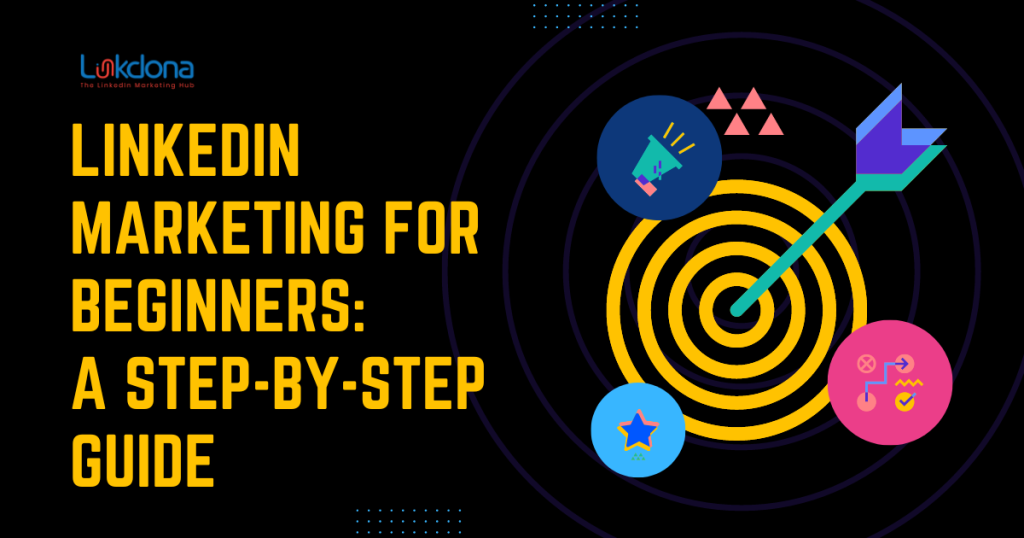
LinkedIn marketing for beginners: a step-by-step guide
By Sangita Stella Chambugang
LinkedIn has emerged as a powerful platform for businesses to connect with professionals, build networks, and expand their reach. In this comprehensive guide, we will take you through the essential steps and strategies for LinkedIn marketing as a beginner. Whether you’re a small business owner, a freelancer, or an aspiring professional, leveraging LinkedIn can open doors to exciting opportunities. Let’s dive in!
Step 1: Setting up Your LinkedIn Profile
A. Creating a professional profile:
- Choosing a profile picture: Select a high-quality, professional headshot that reflects your personal brand.
- Writing a compelling headline and summary: Craft a concise and attention-grabbing headline, followed by a compelling summary that highlights your expertise and value proposition.
- Highlighting key skills and experiences: Showcase your skills, experiences, and achievements to build credibility and attract the right connections.
Step 2: Building a Strong Network
A. Connecting with relevant professionals:
- Identifying target audience and industry: Define your target audience and industry to narrow down your networking efforts.
- Sending personalized connection requests: Customize your connection requests to demonstrate genuine interest and increase the likelihood of acceptance.
- Joining LinkedIn groups and engaging in discussions: Find relevant LinkedIn groups where your target audience congregates. Engage in discussions, share insights, and build relationships.
Step 3: Developing a Content Strategy
A. Understanding LinkedIn content types:
- Text-based posts: Share short and impactful updates, industry news, or thought-provoking questions to spark engagement.
- Articles and blog posts: Utilize LinkedIn’s publishing platform to share long-form content, industry insights, and thought leadership articles.
- Images, videos, and presentations: Use visual content to grab attention, showcase your work, and provide valuable information.
B. Creating engaging and valuable content:
- Identifying trending topics in your industry: Stay updated with industry trends, news, and challenges to create relevant and timely content.
- Providing insightful tips and advice: Share your expertise by offering practical tips, how-to guides, or actionable advice that resonates with your target audience.
- Showcasing your expertise through case studies and success stories: Share success stories, case studies, and client testimonials to build trust and demonstrate your capabilities.
Step 4: Engaging with Your Network
A. Building relationships through engagement:
- Liking, commenting, and sharing relevant content: Engage with your network by showing appreciation for their posts, sharing valuable insights, and initiating conversations.
- Responding to comments and messages promptly: Be responsive to comments, messages, and connection requests to nurture relationships and foster engagement.
- Participating in LinkedIn discussions and groups: Engage in group discussions, contribute valuable insights, and establish yourself as a trusted authority in your field.
B. Nurturing relationships with personalized messages:
- Sending personalized messages to new connections: Introduce yourself, express interest in their work, and explore potential collaborations or partnerships.
- Following up with existing connections: Stay in touch with your connections by sending personalized messages, sharing relevant content, or congratulating them on their achievements.
E. Monitoring and responding to social signals:
- Tracking engagement metrics: Monitor the performance of your posts, articles, and videos to understand what resonates with your audience.
- Responding to comments and messages promptly: Engage in meaningful conversations, address inquiries, and show appreciation for feedback.
F. Collaborating and supporting others:
- Seeking collaboration opportunities: Identify professionals or businesses with complementary skills or target audiences and explore collaboration possibilities.
- Supporting others: Celebrate the successes of your connections, share their content, and provide support whenever possible.
Step 5: Leveraging LinkedIn Features and Tools
A. Utilizing LinkedIn Pages:
- Creating and optimizing a company page: Set up a professional company page, complete with a compelling description, logo, and relevant information.
- Showcasing products and services: Utilize the product and services section to highlight your offerings and provide detailed information.
- Monitoring analytics and insights: Leverage LinkedIn’s analytics to gain insights into your page performance, audience demographics, and engagement metrics.
B. Running LinkedIn ad campaigns
B. Running LinkedIn ad campaigns:
- Setting campaign objectives and targeting options: Define your campaign goals, select target demographics, and choose relevant ad formats.
- Creating compelling ad content: Craft engaging ad copy, select eye-catching visuals, and incorporate a strong call-to-action.
- Tracking and optimizing campaign performance: Monitor ad performance, analyze key metrics, and make data-driven adjustments to optimize your campaigns.
Step 6: Monitoring and Analyzing Your LinkedIn Marketing Efforts

A. Using LinkedIn analytics:
- Tracking engagement metrics: Monitor post views, likes, comments, and shares to gauge the success of your content.
- Identifying the success of different content types: Analyze the performance of different content formats to understand what resonates best with your audience.
- Adjusting strategies based on performance data: Use the insights gained from analytics to refine your content strategy and optimize future campaigns.
B. Leveraging third-party analytics tools:
- Incorporating Google Analytics: Integrate Google Analytics with your LinkedIn marketing efforts to gain a deeper understanding of user behavior and website traffic.
- Utilizing social media management tools: Leverage social media management tools that offer LinkedIn analytics to track and measure your overall social media performance.
C. Conducting A/B testing:
- Testing different content formats: Experiment with different content types, headlines, or visuals to identify the most effective approaches.
- Testing ad campaigns: A/B test your ad campaigns by trying different ad copies, visuals, or targeting options to optimize performance.
D. Monitoring competitor activity:
- Analyzing competitor profiles: Observe the content, engagement, and strategies of your competitors to gain insights and identify areas for improvement.
- Staying updated with industry trends: Monitor the LinkedIn activities of industry leaders and competitors to stay informed about the latest trends and innovations.
E. Regular reporting and review:
- Establishing reporting metrics: Define key performance indicators (KPIs) that align with your business goals and regularly track and report on these metrics.
- Reviewing and refining your LinkedIn marketing strategy: Continuously evaluate the effectiveness of your LinkedIn marketing efforts, identify areas for improvement, and adapt your strategy accordingly.
Step 7: Networking and Relationship Building Tips
A. Attending LinkedIn events and webinars:
- Participating in virtual events: Attend virtual events and webinars to learn from industry experts, expand your network, and discover new opportunities.
- Engaging with event participants: Actively participate in discussions, connect with speakers and attendees, and share valuable insights.
B. Reaching out to influencers and thought leaders
- Identifying relevant influencers: Identify influencers and thought leaders in your industry and engage with their content by liking, commenting, and sharing.
- Building relationships with influencers: Connect with influencers, introduce yourself, and explore opportunities for collaboration or mentorship.
C. Building partnerships and collaborations
- Seeking complementary businesses: Identify businesses or professionals with complementary offerings and explore potential partnerships or collaborations.
- Sharing resources and knowledge: Foster mutually beneficial relationships by sharing resources, expertise, or industry insights.
D. Engaging in LinkedIn groups and communities
- Joining industry-specific groups: Find and join LinkedIn groups relevant to your industry or niche to connect with like-minded professionals.
- Contributing to discussions: Actively participate in group discussions, provide valuable insights, and establish yourself as a trusted and knowledgeable professional.
E. Providing value through recommendations and endorsements
- Writing thoughtful recommendations: Show appreciation for the skills and expertise of your connections by writing genuine and meaningful recommendations.
- Endorsing relevant skills: Endorse the skills of your connections to validate their expertise and strengthen your professional relationships.
Step 8: Engaging in meaningful conversations and active listening
Building relationships through engagement:
- Engaging in one-on-one conversations: Initiate conversations with your connections, ask questions, and show genuine interest in their work or opinions.
- Actively listening and responding: Pay attention to the needs and challenges of your connections, offer support, and provide valuable insights.
G. Linkedin marketing for beginners: Offering assistance and support
- Providing value-added resources: Share relevant articles, e-books, or industry reports that can benefit your connections.
- Offering help and support: Extend your assistance to your connections whenever possible, whether it’s offering advice, making introductions, or sharing opportunities.
Conclusion:
LinkedIn marketing can be a game-changer for businesses and professionals looking to expand their network, establish thought leadership, and drive business growth. By following this step-by-step guide, you’ll be equipped with the knowledge and strategies needed to make the most of LinkedIn’s potential. Remember, consistency and genuine engagement are key to building meaningful relationships and reaping the benefits of LinkedIn marketing. Now, it’s time to take action and unlock the endless possibilities waiting for you on LinkedIn.
As you embark on your LinkedIn marketing journey, always remember to adapt your strategies based on your specific goals, target audience, and industry trends. With dedication and a well-executed plan, LinkedIn can become a valuable asset in your business arsenal. So, embrace the power of LinkedIn, connect with professionals, share valuable insights, and watch your network and business grow. Get started today and unlock the boundless opportunities that await you on LinkedIn!
